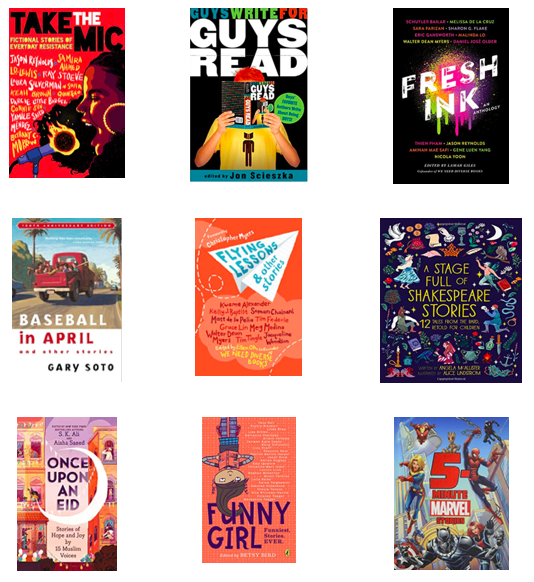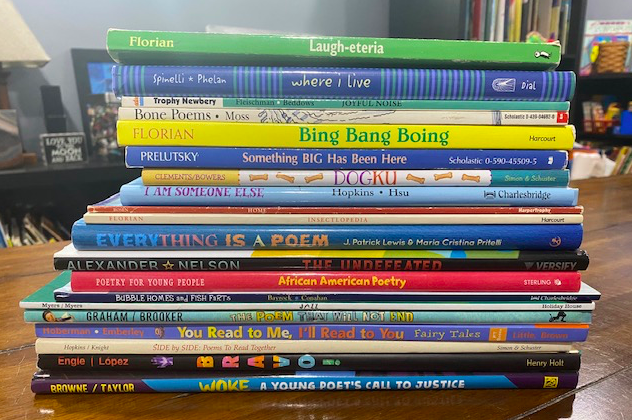Written by Julie Wright & Elizabeth Keim
Last spring, when the world did an abrupt pivot and teachers and parents were suddenly teaching on screens from home, we offered a series of blog posts. We suggested using short texts that could be found “right at our fingertips” to create access and interest to keep children reading. Please find all the posts below:
Short Texts at Your Fingertips: Launching into Summer Reading
Short Texts at Your Fingertips: Launching into Summer Writing
“WARM UP” THOSE READING MUSCLES
Now it is August. The hoped-for, regular, back-to-school, normal that we are used to is clearly not going to happen. Instead, we are faced with a lot of uncertainty and a myriad of education models. Whether you are teaching remotely, face-to-face, or in a hybrid model, you will be meeting children who have not been in a classroom in more than 5 months. While we hope that each of them had a rich reading life all summer, we will be facing a wide variety of experiences and skills.
Short texts offer a way to ease back into reading in a comfortable, low-stakes way because they are easy to read and discuss in one sitting. Short texts are great to use with students across grade levels and content areas because they:
Create conversation starters that can positively impact whole group, small group and one-to-one learning
Increase reading volume by reading widely (lots of topics) and deeply (read a lot about one topic)
Help students read the world around them, not just what they find in books
Short texts give us reasons to read, write, talk, and think because they entertain, inform, and often inspire us. Here’s what we mean.
Entertain -- brings us joy
Inform -- teaches us new information and/or renews our thinking about ideas and topics
Inspire -- motivates us to read, write and share more
BUILDING COMMUNITY
When we ask a group of students to read the same short text, whether they are face-to-face in the same room or interacting online, it gives them a common experience and a way to build community and positive relationships. Here are some examples of short texts your students might enjoy!
ELEMENTARY
Picture books are wonderful short texts! Check out these resources about friendship, community and being an upstander! Click the links below to order copies!
My Friend is Sad by Mo Willems
Use the text as reader’s theater.
Examine the thought and speech bubbles and the use of punctuation.
The Invisible Boy by Trudy Ludwig
Read the story aloud and discuss their friendship.
Discuss the problem in this story and how it is resolved.
Strictly No Elephants by Lisa Mantchev
Discuss how it feels to be excluded.
Discuss how it feels to be included.
Use this book as a springboard to creating a classroom community where all feel included.
Giraffe Problems by Jory John
Read this story aloud or listen and watch it using this link.
Discuss the giraffe’s perspective compared to the other animals.
Make a list of ways we can be a good friend to others.
The Power of One by Trudy Ludwig
Talk about different ways to be an upstander.
Think about and discuss, What is an “act of kindness”?
Make a list of different acts of kindness that we can do for one another each day.
MIDDLE SCHOOL
Excerpts of novels, picture books, podcasts and short stories are great to use when curating short texts. Reading short texts often leads to reading longer texts, especially when students’ interests have been piqued or they connect with authors. Check out these resources about friendship, community and being an upstander!
Two Naomis by Olugbemisola Rhuday-Perkovich
Read an excerpt from the book.
Read and/or write a review about the book.
Listen to the podcast with Olugbemisola Rhuday-Perkovich.
Read the entire book together or offer it to students who may want to read it independently.
In addition, check out 50 Must Read Middle School Friendship Stories curated by Book Riot for more ideas!
Weslandia by Paul Fleischman
Discuss what it means to accept [and show acceptance of] others.
Talk about ways we can ensure that everyone in our learning community feels accepted and welcome.
One by Kathryn Otoshi
This book, often thought of as a book to read with younger students, is an amazing story to spark discussion with older students.
Share and discuss the definition of upstander.
Discuss what it means to be an upstander.
Investigate websites committed to anti-bullying work. Here’s one example.
Dear Bully: Seven Authors Tell Their Stories by Dawn Metcalf
Read aloud and discuss one story or give students an opportunity to read several stories from this anthology.
Find and share quotes related to being an upstander such as, “If not now, then when? If not me, then who?” [Hilell].
Dictionary of a Better World: Poems, Quotes, and Anecdotes from A to Z by Irene Latham
Explore this book and the many words, definitions, ideas, and illustrations across several days.
Give students an opportunity to talk about how they can apply each word to create a better, more accepting, world.
TRY THIS!
Step 1
Choose a short text that you feel will grab your readers’ interests such as a short magazine article or a top ten list. Look for an engaging and “easy” text. This experience should be fun, more like dipping your toe into a nice warm bath than plunging into an ice cold lake. Find a way to make it available to your readers. Consider print copies or post it in a place where your students can either read it online or print it for themselves. Before reading, ask students:
What do you notice about this piece?
Title
Author
Illustrations, images or graphic elements
Headings, subheadings
What do you already know about this topic?
What do you wonder?
Step 2
Read the text. Decide if you want students to mark the text in some way to hold their thinking or if you want students to make that decision. Consider sharing ways students could hold their thinking to note important or interesting information. Students could:
Take notes in a notebook or on a piece of paper.
Use sticky notes to capture their thinking.
Create margin notes and/or highlight words, sentences or sections.
Step 3
Share your thinking with others. Some ways to do this include:
Pose a question and have everyone answer it (on a post-it or via an online forum). Provide time to read others' answers.
Ask readers to pose a question, then have readers answer someone else’s question.
If students noted their thinking in some way, ask them to pick 1-2 ideas to share with others.
Step 4
Look for other reading, writing and talking opportunities using this short text type.
Reading Ideas
Present students with another short text similar to the first. Compare them.
Present students with another piece that is on the same or similar topic, but is a different genre (e.g. both pieces are about penguins: one is an article and the second is a poem). Compare the pieces.
Writing Ideas
Use the short text as a mentor text. Writers write about a topic they know a great deal about using the same genre and style as the piece you read together.
Make a top ten list. Be sure to share them with others.
Talking Ideas
Invite conversation about students’ reading lives. Ask:
Where do you like to read?
How long do you like to read?
What types of texts do you like most? Least?
Step 5
Invite students to share other things they have been reading. Students could share book titles, but it could also mean that they talk about other text types and genres they particularly like (e.g. graphic novels or magazines or a reading website).
COMING SOON!
Short Texts: Mighty Mentors That Move Readers and Writers Forward by Julie Wright & Elizabeth Keim (Benchmark, 2021).










